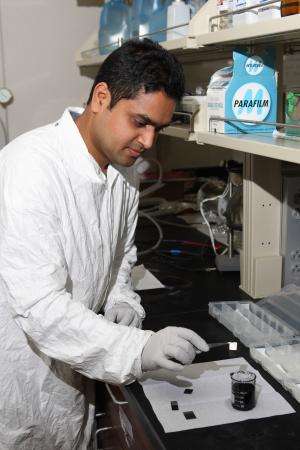Streamlining thin film processing saves time, energy

Energy storage devices and computer screens may seem worlds apart, but they're not.
When associate professor Qi Hua Fan of the electrical engineering and computer science department set out to make a less expensive supercapacitor for storing renewable energy, he developed a new plasma technology that will streamline the production of display screens.
For his work on thin film and plasma technologies, Fan was named researcher of the year for the Jerome J. Lohr College of Engineering. His research focuses on nanostructured materials used for photovoltaics, energy storage and displays.
Making electrodes for supercapacitors
Last spring Fan received a proof-of-concept grant from the Department of Energy through the North Central Regional Sun Grant Center to determine if biochar, a byproduct of the a process that converts plants materials into biofuel, could be used in place of expensive activated carbon to make electrodes for supercapacitors.
Sun Grant promotes collaboration among researchers from land-grant institutions, government agencies and the private sector to develop and commercialize renewable, bio-based energy technologies. The proof-of-concept grants allow researchers to advance promising research to the next level of toward product development and commercialization.
"The amount of charge stored in a capacitor depends on the surface area," Fan explained, "and the biochar nanoparticles can create an extremely large surface area which can then hold more charge."
He deposits the biochar on a substrate using a patent-pending electrochemical process he developed and licensed to Applied Nanofilms LLC, in Brookings. Applied Nanofilms and Wintek, a company that makes flat panel displays for notebooks and touch screens in Ann Arbor, Michigan, provided matching funds.
Through this project, Fan developed a faster way of treating the biochar particles using a new technology called plasma activation. "Treating means you use plasma to change the material surface, such as creating pores," Fan said.
The plasma treatment activates the biochar in five minutes and at room temperature, Fan explained. Conventional chemical activation takes several hours to complete and must be done at high temperatures—approximately 1,760 degrees Fahrenheit.
"This saves energy and is much more efficient," Fan said. In this project, he has been collaborating with assistant professor Zhengrong Gu in the agricultural and biosystems engineering department, whose research focuses on energy storage materials and devices. They plan to use these promising results to apply for federal funding.
Applying plasma process to displays
The technique that treats biochar electrodes for supercapacitors can also be used in making displays, explained Fan, who was a research scientist at Wintek more than 10 years ago. Since last fall, Fan has been collaborating with Wintek on ways of producing more efficient, better performing materials, such as silicon and carbon thin films, for the company's displays.
"Plasma processing is a very critical technology in modern optoelectronic materials and devices," Fan explained. The high-energy plasma can deposit highly transparent and conductive thin films, create high quality semiconductors, and pattern micro- or nano-scale devices, thus making the display images brighter and clearer.
Fan will work with Wintek to develop a prototype plasma system. The activation method has the potential to improve production efficiency, saving time and energy, he noted.
Provided by South Dakota State University




















